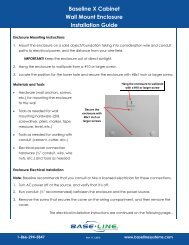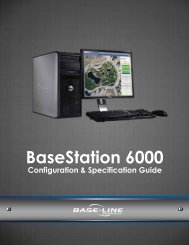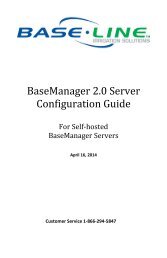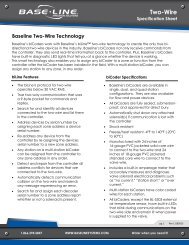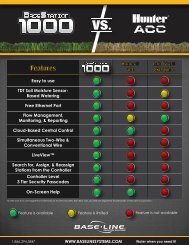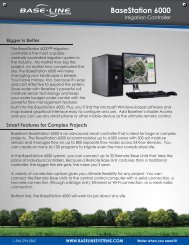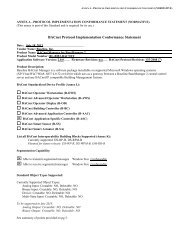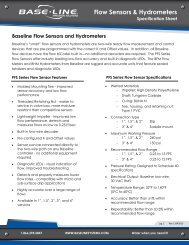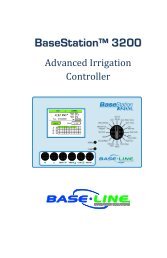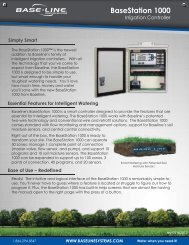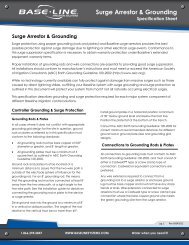BaseStation 3200 User Manual â 11.7.5.15 ... - Baseline Systems
BaseStation 3200 User Manual â 11.7.5.15 ... - Baseline Systems
BaseStation 3200 User Manual â 11.7.5.15 ... - Baseline Systems
You also want an ePaper? Increase the reach of your titles
YUMPU automatically turns print PDFs into web optimized ePapers that Google loves.
<strong>BaseStation</strong> <strong>3200</strong> Advanced Irrigation Controller <strong>Manual</strong><br />
Note: Root depth and water requirements for trees and shrubs vary much more greatly than for turf. Consult an<br />
experienced Arborist or Master Gardener for specific guidelines for watering trees.<br />
Most trees are watered along with turf in commercial landscapes. In this case, <strong>Baseline</strong> recommends that you<br />
install biSensors in the turf areas and that you adjust the default run times of zones with trees to ensure water<br />
application to 12 inches or whatever is required to optimize tree health.<br />
Installing biSensors with New Trees<br />
In the case of new landscape with newly installed trees that are watered separately from turf zones, it is important<br />
to make sure that the sensor is located as close to the root ball in the top 1/3 of the root ball as possible. Watering<br />
new trees with a sensor based watering strategy is a good way to avoid inadvertently “drowning” new trees and<br />
shrubs due to overwatering.<br />
Shrubs and Other Ornamental Plants<br />
Many landscapes feature shrub zones that are separately watered from turf zones. Shrubs generally have very<br />
different water needs from turf, so having separate zones is a good thing!<br />
For shrub zones, choose a representative plant, and then install the in or close to the top 1/3 of the root zone for<br />
the plant, without damaging the root structure of the plant.<br />
If drip emitters or bubblers are used, install the sensor in a location that is not directly under the emitter or<br />
bubbler to avoid partial watering of the whole root zone of the plant.<br />
Gardens and Crop Plants<br />
Sensors are excellent tools for maximizing crop results. They have been used for decades in irrigated agriculture.<br />
Garden and crop plant watering depends greatly on the type of plants being grown, and a discussion of this topic is<br />
beyond the scope of this manual.<br />
To plan a watering strategy for larger gardens or crops, <strong>Baseline</strong> recommends that you contact your local<br />
Cooperative Extension Office. You can find a national register of the extension offices at:<br />
http://www.csrees.usda.gov/Extension/<br />
Watering Strategies<br />
Each property is unique and has unique watering requirements. In order to support a broad range of climate<br />
zones, plant types, landscape designs, and landscape usage requirements, the <strong>BaseStation</strong> <strong>3200</strong> provides a variety<br />
of watering strategies.<br />
The basic watering strategies supported by the <strong>3200</strong> are shown in the following table.<br />
Timed<br />
Historical<br />
ET<br />
Lower Limit<br />
Like all irrigation controllers, you can program the <strong>3200</strong> to run zones on specific times and dates.<br />
Timed irrigation is the default setting for any zone that has not been associated with a moisture<br />
sensor. Refer to Setting Up a Timed Zone on page 43.<br />
The <strong>BaseStation</strong> <strong>3200</strong> allows you to set the days between irrigation according to a Historical ET<br />
calendar. This watering strategy, unlike typical seasonal adjustments, will promote deeper root<br />
growth and healthier plants throughout the season. However, Historical ET based watering will<br />
not protect your landscape from unusual weather patterns in any given season. Read the topic<br />
To set up historical ET-based watering for a program on page 49.<br />
Also called Lower Threshold. In this soil moisture based, smart watering strategy, irrigation is<br />
suspended or skipped until the soil dries to the lower limit, which may be set manually, or set<br />
using the automatic calibration process. This watering strategy naturally waters deeply and<br />
Page 7



